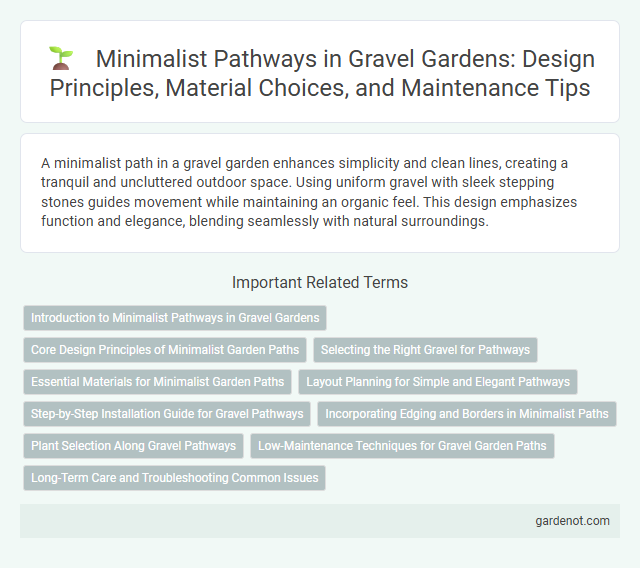A minimalist path in a gravel garden enhances simplicity and clean lines, creating a tranquil and uncluttered outdoor space. Using uniform gravel with sleek stepping stones guides movement while maintaining an organic feel. This design emphasizes function and elegance, blending seamlessly with natural surroundings.
Introduction to Minimalist Pathways in Gravel Gardens
Minimalist pathways in gravel gardens emphasize simplicity, clean lines, and functionality to create an open, airy space that complements the natural environment. These pathways typically utilize compacted gravel or pebbles combined with stone slabs or concrete pavers to maintain a sleek, unobtrusive design. Embracing minimalism reduces maintenance needs while enhancing the garden's overall aesthetic by promoting harmony between pathways and surrounding plantings.
Core Design Principles of Minimalist Garden Paths
Minimalist gravel garden paths emphasize simplicity, clean lines, and functional flow to create an uncluttered outdoor space. Core design principles include using natural materials, maintaining consistent texture, and prioritizing ease of movement through unobtrusive, well-defined paths. These elements enhance tranquility while complementing surrounding landscape features with subtle elegance.
Selecting the Right Gravel for Pathways
Choosing the right gravel for a minimalist path involves considering size, texture, and color to create a clean, cohesive look. Fine gravel, such as pea gravel or decomposed granite, compacts well and offers smooth walking surfaces ideal for minimalist designs. Light-colored gravel enhances brightness while darker tones provide contrast, complementing the garden's natural elements seamlessly.
Essential Materials for Minimalist Garden Paths
Gravel garden paths emphasize essential materials like crushed stone, pea gravel, and landscape fabric to ensure durability and low maintenance. Selecting natural, permeable stones supports water drainage and prevents soil erosion, enhancing the garden's sustainability. Minimalist designs prioritize simplicity by using uniform gravel texture and neutral colors to create clean, unobtrusive walkways.
Layout Planning for Simple and Elegant Pathways
Minimalist paths in gravel gardens emphasize clean lines and uncluttered layouts, enhancing the garden's simplicity and elegance. Careful layout planning ensures pathways complement surrounding plants and features, creating a harmonious flow and easy navigation. Using uniform gravel textures and subtle edging materials reinforces a refined, understated aesthetic.
Step-by-Step Installation Guide for Gravel Pathways
Create a minimalist gravel path by first marking the desired walkway and excavating the area to a depth of about 4-6 inches. Next, lay a geotextile fabric to prevent weed growth and improve drainage before spreading a 2-inch layer of crushed stone as a stable base. Finish with a 2-3 inch layer of fine gravel, compacting it firmly to achieve a smooth, durable surface ideal for minimalist garden design.
Incorporating Edging and Borders in Minimalist Paths
In minimalist gravel garden paths, incorporating clean, unobtrusive edging and borders enhances structure while maintaining simplicity. Materials like metal, concrete, or natural stone create crisp delineations that prevent gravel displacement and define the pathway clearly. This approach optimizes functionality and aesthetic appeal by balancing minimalism with practical containment.
Plant Selection Along Gravel Pathways
Choosing drought-tolerant plants such as lavender, sedum, and ornamental grasses enhances the minimalist aesthetic along gravel garden pathways while requiring minimal maintenance. Incorporating native species like creeping thyme and blue fescue provides texture and seasonal interest, promoting ecological balance. Strategic spacing and low-growing varieties maintain clean lines and unobstructed walking areas, reinforcing the simplicity of the gravel path design.
Low-Maintenance Techniques for Gravel Garden Paths
Minimalist paths in gravel gardens emphasize simplicity and functionality, using clean lines and natural materials to create a serene walkway. Incorporating low-maintenance techniques such as compacted gravel beds with stabilizers, weed barriers, and edging materials helps prevent erosion and weed growth, reducing upkeep significantly. Proper drainage solutions and periodic raking maintain the path's appearance while ensuring long-term durability and minimal intervention.
Long-Term Care and Troubleshooting Common Issues
A minimalist gravel garden path requires long-term care including regular raking to prevent weed growth and maintaining an even surface to avoid water pooling. Common issues such as gravel displacement can be addressed by edging installation and replenishing stones as needed to preserve structure and appearance. Proper drainage solutions minimize erosion and extend the durability of the pathway in a minimalist gravel garden.
Minimalist path Infographic

 gardenot.com
gardenot.com